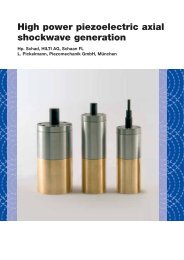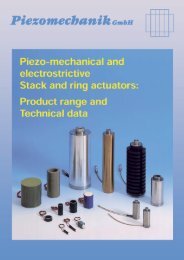231575 Piezo-Mechanics GB
231575 Piezo-Mechanics GB
231575 Piezo-Mechanics GB
You also want an ePaper? Increase the reach of your titles
YUMPU automatically turns print PDFs into web optimized ePapers that Google loves.
3.9. Thermal propertiesThe stability of piezoactuators at high temperatures isnot only determined by the properties of thepiezoceramic, but also by the used accessory materialssuch as insulating coatings, electroding, adhesives etc...The Curie temperature of the ceramic is in most casesnot the limiting factor. An important aspect for industrialapplication is, that actuators shall not only withstandwide temperature variations, but also shall show onlysmall changes in their properties. Here the materialcomposition HS is unrivaled (see chapter 3.2.).The use of actuators under cryogenic conditions is astandard application.Selfheating<strong>Piezo</strong>actuators show self-heating proportional to thereactive power balance during dynamic operation,increasing therefore with actuation frequency and amplitude.The tendency to dramatic self-heating is furtherenhanced by the poor internal heat management forstandard mounted actuators with the sole mechanicalcontacts of the ceramic stacks via the endfaces.Heat-sinking by this arrangement is very poor due to thelow thermal conductivity of PZT ceramic and the poorheat transfer for cased actuators with an airgap betweenceramic stack and casing.The consequences are severe frequency limitations forthe operation of piezoactuators to avoid overheating.Normal low voltage actuators with mid sized diameterstend to overheat for frequencies in the range of about200 Hertz/full stroke operation.To make use of the full dynamic potential of piezoactuatorswith high frequency/amplitude rates inlong-term operation, a consequent heat managementis necessary to remove heat efficiently fromthe piezostack.The solution is the unique ThermoStable configurationprovided to PIEZOMECHANIK’s actuators(option 3.9.).Thermal expansionLow voltage actuators show a thermal axial expansioncoefficient of –3 ppm/°K (measured for short circuitedactuator).Discretely stacked high voltage actuators show highervalues due to the ceramic/metal/adhesive compoundstructure of about +1 ppm/°K. High voltage actuatorsfrom other sources sometimes show very high thermalexpansion due to oversized adhesive layers.For actuators with casing the mechanical endpiecescontribute to the total thermal expansion. This effect canbe minimized by the use of INVAR alloy.Low temperature properties:The piezomechanical and electrical properties of PZTceramic depend on temperature. When piezoactuatorsare cooled down to 77 °K (LN2) or even lower towardsthe 4° Kelvin region, any PZT ceramic behaves like apiezoelectrically very hard piezo material featuring• strong reduction of electrical capacitance• reduction of loss factor / reduced hysteresis• reduced piezoelongation factor d33• strong increase of the coercive field strengthThe last point means, that at low temperatures apiezostack becomes extremely stable against electricaldepoling and other destabilizing effects.So a much wider voltage swing (bipolar operation)compared to room temperature is possible now.Thereby, the loss in stroke for low temperature canbe partially compensated for.In the following the main properties of the standard softPZT PSt 150 actuators are compared for roomtemperatureand cryogenic temperatures.Standard capacitance stroke for 0V/ max. operatingPSt 150 (+)150V voltage rangeroomtemp. 100% 100% (–) 30 V / (+) 150 V77 °K 15 % 20% (–) 150 V / (+) 150 V4 °K 5 % 6 % (–) 300 V / (+) 300 VOther PZT materials show qualitatively the same trend.For hard and semi hard PZT materials the loss in strokeduring cool down is not dramatic as for soft PZT materialsas used with the standard PSt 150 stacks.Fig. 16: IR thermography of a piezostack PSt 1000/16/40conventionally mounted via the endfaces in thermalEquilibrium for 1000 V/150 Hertz excitation.The hotspotting in the stack’s center with about 100 °Cis evident as well as the temperature gradient towardsthe cool endpieces (approx. 30 °C).16





